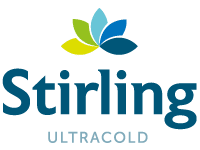As we recently celebrated the passing of one year to the next, there was an ever-present yearning that united us all…A sense of relief that 2020 was finally over! Regardless of who you are, or where you were, COVID-19 has added some level of challenge to your life. The emotional and economic toll of the pandemic has caused great suffering for many, some more than others, as tragic losses continue on a global scale into 2021.
While not diminishing the pain of 2020, it should also be noted that it was still a year of accelerated change and growth in our values, sense of interdependence and our ability to adapt as people, businesses, communities and societies. As difficult as it was, this past year has given us new and valuable perspectives and left many of us reflecting with a feeling of thankfulness and gratitude. At Stirling Ultracold, we are thankful for the courage and dedication of our first responders and healthcare workers and grateful for many of our pharmaceutical customers, who worked tirelessly to develop safe vaccines.
Unprecedented, Rapid Change in Ultra-Low Freezer Applications
Looking back on the year, as the grip of COVID-19 was locking businesses down, our new CEO, Dusty Tenney, had just started to lead our organization. Life at Stirling was far from business-as-usual and many worried about an uncertain future. Nevertheless, we saw our research and clinical customers quickly realign, adapt and put together a battle plan against the virus. It may not have happened overnight, and was messy at times, but researchers and clinical diagnosticians came together for a singular purpose, working from home in many cases until they could physically return to the lab—inspiring the world.
Soon, this groundwork coalesced into new projects, plans and budgets, almost exclusively focused on combating COVID-19. This led to a realignment of ULT freezer applications in support of biosecure vaccine R&D, specimen handling for virus testing, biorepository expansion and biologics cold chain distribution, breathing new life into Stirling Ultracold.
Our customers’ amazing response to the pandemic has forever changed our perspective at Stirling Ultracold and modeled the way we would finish the year. It was our turn to pick up the torch! We saw that our critical role and responsibility in this crisis went beyond meeting the unprecedented demand for quality ULT freezer products, and ultimately included offering guidance in the application of our ULT storage products for the COVID-19 cold chain. This led us to develop “hub and spoke” packages for last mile distribution and regional COVID-preparedness teams, leveraging the value of our unique portable and compact ULT products, custom vial racking and our exclusive -20°C to -86°C temperature setpoint range for the effort. With more than one intervention required to end COVID-19 quickly, multiple ULT and refrigeration manufacturers will also be needed to meet unprecedented demand.
The following is a summary of lessons learned this year on ultra-low storage needs, as refined in the crucible of supporting rapid cold chain deployment at an unprecedented scale…
What Matters in the New World of ULT Storage
- Wide Temperature Range: Organizations must be prepared for the range of temperatures at which multiple COVID-19 vaccines are stored. Not being able to meet the storage requirements of any one of the approved vaccines will limit vaccine administration options at the point of patient care, especially considering multi-dose patient requirements.
The smart play is to cover all the bases by choosing ULT freezers with the widest temperature setpoint range to optimize ultracold storage for most/all biologic candidates. Only Stirling freezers can accommodate this full range with a single model. - Infrastructure Readiness: Facility infrastructure obstacles, such as floor space constraints, high energy draw, power distribution and limited HVAC capacity, can hamper deployment of ultra-low freezer capacity. This can be mitigated by selecting ULT models, such as ours, with higher storage densities that require less space, energy and infrastructure to operate over a wider range of ambient conditions and voltages.
- Small Freezer Footprint and Portability: Regional/local leaders are being challenged to get biological materials from central repositories to remote or immobile communities like extended care facilities, nursing homes and rural populations, without breaking the cold chain. This is where traditional ULT freezers are too bulky, heavy and generally impractical, while dry ice cooling is limited by supply issues, safe handling challenges and short cooling life spans.
For these reasons, healthcare facilities and pharmacies are choosing to deploy our uniquely portable ULT25NEU appliance. Weighing only 21kg/46 lbs., this unit and can be powered by any standard power source, worldwide, as well as a DC automotive adaptor for mobile transport. - Limited Heat Output and HVAC Load: Many ULT models produce excessive heat as a by-product of ultracold temperature production. The more ULTs running in a facility, such as a biobank in a central warehouse, the more heat that builds up within the building interior. These rising ambient temperatures can have significant impact on ULT performance, reliability and efficiency. This may cause HVAC systems to work harder, especially in warmer climates and seasons, leading to increased strain on building systems, higher energy costs and can even lead to freezer failures.
These issues can be significantly mitigated by installing high-efficiency, ENERGY STAR®-certified ULT freezer models that can generate significantly less heat. It also helps that Stirling models perform reliably at warmer ambient temperatures up to 35°C/95°F. - Simplified Electric Power Distribution: Ultra-low freezers typically plug into high-voltage power outlets with multiple power supply requirements when deploying units in various regions of the world. Organizations can avoid building modification delays and careful planning of ULT freezer power options to meet regional standards, by installing ULTs with a wide voltage range and universal power built in. By merely changing power cords, Stirling Ultracold models automatically switch across voltages, including standard outlets from 110 to 240 volts. Stirling-powered units are also brownout tolerant, making them ideal for rural and developing regions with low-grade power sources.
- Integrated and Cloud-based Temperature Monitoring: To assure the efficacy of biologic doses throughout the distribution process, it is essential that temperature logging or monitoring be used to establish a cold chain audit trail. USB trackers or real-time wireless monitoring devices can be used, although Cloud-based monitoring platforms, such as SenseAnywhere, offer the advantage of allowing continuous cold chain of custody through multiple stages of the distribution process.
New Perspectives That Extend into the Post-COVID World
With the limited availability, life span and temperature control of dry ice cooling, ULT storage will become increasingly critical in all phases of the coming mRNA revolution.
2020 may be remembered as the year when the “ultracold freezer” became surprisingly visible in global media coverage and took its place in pandemic history. While this resulted from a once-in-century global healthcare crisis, it now appears that ULT storage will become an essential enabler to other critical biomedical developments, as we enter 2021 and beyond.








